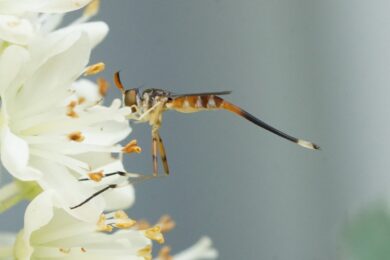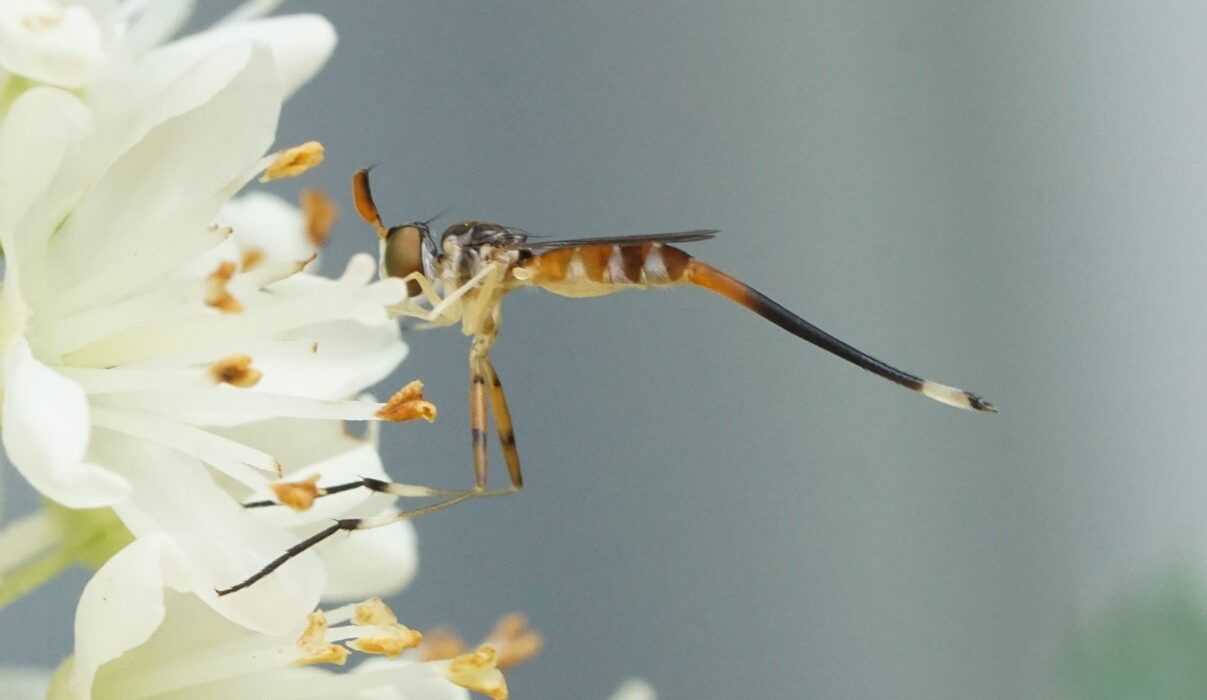
Sometimes there’s a species that you just really, really, REALLY want to see!
It’s not truly rare, but the bizarre-looking fly Stylogaster neglecta caught my attention years ago. Females are especially strange, with a tube-like ovipositor that is almost as long as the rest of the body; but even the males are odd-looking, with elongated legs and exaggerated antennae. From the moment I learned of this fly’s existence, I’ve hoped to see one, but the species eluded me.
On July 22, 2024, I was noting a seasonal shift in the mix of flowers in bloom outside my organization’s small office building in Vineyard Haven, Massachusetts. Butterfly-weed (Asclepias tuberosa), that quintessential early-summer pollinator plant, had been attracting a great variety of bees, flies, and beetles for several weeks; but that plant’s bloom period was ending, and only a few of its bright orange flowerlets remained open. But as if in compensation, a sweet pepperbush (Clethra alnifolia) shrub right next to the office front door was opening its very first flowers of the season.
Clethra rivals Asclepias as a pollinator plant; around our office’s small meadow restoration, it fills a midsummer gap between the bloom periods of butterfly-weed and goldenrod. So I stepped over to check those first white, fragrant flowers. And there it was.
A female, my very first Stylogaster neglecta was drifting daintily around the Clethra flower cluster, with slow, hovering flight. Every few seconds, she’d land and insert her proboscis into some of the flowers; then she’d drift around for a few seconds before landing again. I managed a handful of decent photographs before she drifted almost straight upward and then disappeared over the roof of the office building.

Stylogaster resides in a single-genus subfamily, Stylogastrinae, within the family Conopidae (with the not very flattering common name “thick-headed flies). Some authorities treat Stylogastrinae as its own full family, reflecting the preposterous structure of these insects. Like all Conopids, all Stylogaster species (three in North American, others in Africa and the Neotropis) are parasites. Their larvae develop inside particular host species. But the genus is unusual among Conopids, most of which are bee parasites, in using Blattaria (roaches) Orthoptera (crickets) as hosts.
Our Stylogaster reportedly parasitizes black-horned tree crickets Oecanthus nigricornis. This is a fairly common species on Martha’s Vineyard, so the presence of its Conopid parasite is not surprising. But this tree cricket is essentially a species of shrub swamps and marsh edges on the Vineyard, and I have never recorded it anywhere near the dry habitat around our office. Perhaps that’s why my Stylogaster did not stick around – she was off in search of more promising habitat for her target species.
I’ve been unable to find any previous records of S. neglecta from the Vineyard; the closest ones I can find, listed in both iNaturalist and the Global Biodiversity Information Facility, are from upper Cape Cod and Plymouth, Massachusetts. This suggests that this fly is truly scarce in the Cape and Islands region.
I was thrilled to finally find this species and was also resigned to going many more years before encountering it again. But, checking the same Clethra bush three days later, I noticed small fly exhibiting the same odd, slow, buoyant flight my female Stylogaster had shown. I tracked it carefully as it drifted among the Clethra leaves until it finally landed on an adjacent holly shrub. Smaller than the female Stylogaster and lacking the impressive ovipositor, it nevertheless shared the overall coloration, gangly legs, and odd antennae. A MALE Stylogaster neglecta!

Male Stylogaster neglecta
Clearly, this is the year for Stylogaster, and I’ve been very lucky to get good photos of both sexes right outside my office. I wish these odd flies all the best and hope the species finds all the tree crickets it wants.
Matt Pelikan is the director of the Martha’s Vineyard Atlas of Life project a BiodiversityWorks. Flies are among the many kinds of insects that he’s fascinated by.
